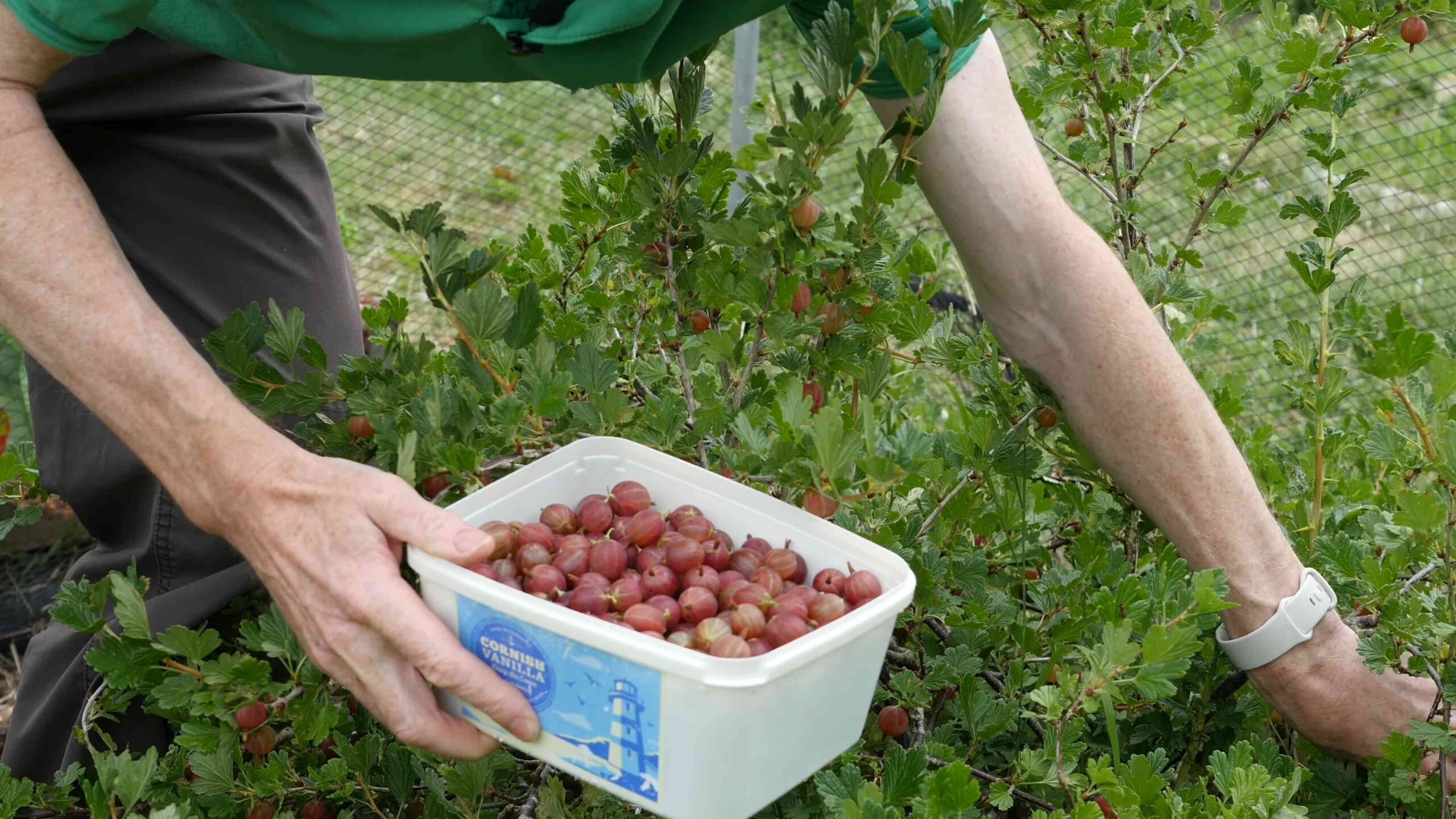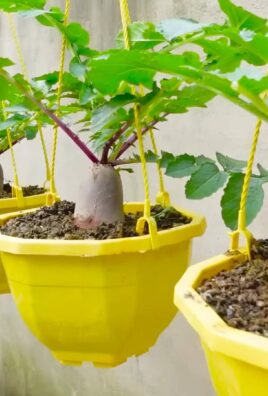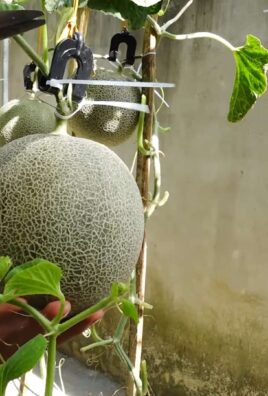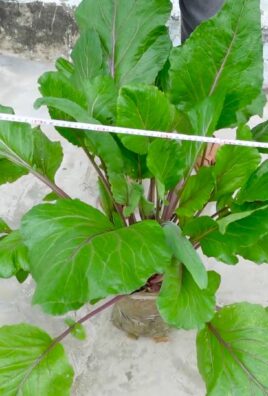Growing Gooseberries can seem daunting, but trust me, with a few simple tricks and a little DIY spirit, you can be harvesting these tart and delicious berries right in your own backyard! I remember my grandmother always had a thriving gooseberry bush, and the pies she made were legendary. Gooseberries have a rich history, dating back to 16th century Europe, where they were prized for their unique flavor and medicinal properties. They were even more popular than blueberries at one point!
But why should you bother with growing gooseberries? Well, for starters, store-bought gooseberries are often hard to find and can be quite expensive. Plus, there’s nothing quite like the satisfaction of nurturing your own food from seed (or in this case, a small bush) to table. This DIY guide is packed with easy-to-follow tips and tricks that will help you navigate the process, from choosing the right variety to protecting your precious berries from pests. I’ll show you how to make your own natural pest deterrents and even how to propagate new plants from cuttings.
Whether you’re a seasoned gardener or just starting out, this article will empower you to successfully start growing gooseberries and enjoy a bountiful harvest for years to come. So, grab your gardening gloves, and let’s get started!

Growing Gooseberries: A Beginner’s Guide to Bountiful Berries
So, you’re thinking about growing gooseberries? Awesome! They’re tart, tangy, and surprisingly easy to cultivate once you get the hang of it. Plus, nothing beats the satisfaction of picking your own fresh berries straight from the bush. This guide will walk you through everything you need to know to successfully grow gooseberries, even if you’ve never gardened before. Let’s get started!
Choosing the Right Gooseberry Variety
Picking the right variety is crucial for success. Some are more disease-resistant than others, and some are better suited to specific climates. Here are a few popular and reliable choices:
* ‘Hinnonmaki Red’: This is a fantastic choice for beginners. It’s incredibly disease-resistant, especially to powdery mildew, which can be a real problem for gooseberries. The berries are red, sweet, and delicious.
* ‘Invicta’: Another excellent disease-resistant variety, ‘Invicta’ produces large, green berries with a good tart flavor. It’s a vigorous grower and a heavy cropper.
* ‘Pixwell’: This variety is known for being nearly thornless, making harvesting much easier! The berries are pinkish-red and have a milder flavor.
* ‘Poorman’: A classic American variety, ‘Poorman’ is very hardy and produces large, red berries with a sweet-tart taste. It’s also relatively disease-resistant.
When choosing, consider your local climate and the level of disease resistance you need. If you live in an area prone to powdery mildew, definitely prioritize a resistant variety.
Preparing the Planting Site
Gooseberries thrive in well-drained soil that’s rich in organic matter. They also need plenty of sunlight, ideally at least 6 hours per day. Here’s how to prepare the perfect planting spot:
* Sunlight: Choose a location that gets full sun to partial shade. More sun generally means more berries, but in very hot climates, some afternoon shade can be beneficial.
* Soil: Gooseberries prefer slightly acidic soil with a pH between 6.0 and 6.5. You can test your soil’s pH with a home testing kit or by sending a sample to your local agricultural extension office.
* Drainage: Good drainage is essential. Gooseberries don’t like soggy roots. If your soil is heavy clay, amend it with plenty of compost and other organic matter to improve drainage.
* Weed Removal: Clear the planting area of all weeds and grass. This will reduce competition for nutrients and water.
* Soil Amendment: Dig in plenty of compost, well-rotted manure, or other organic matter to enrich the soil. This will provide essential nutrients and improve soil structure.
Planting Your Gooseberry Bush
The best time to plant gooseberries is in the early spring or late fall, when the plants are dormant. Here’s how to plant them properly:
1. Dig the Hole: Dig a hole that’s twice as wide as the root ball and just as deep.
2. Amend the Soil (Again!): Mix some compost into the soil you removed from the hole.
3. Remove the Plant from its Container: Gently remove the gooseberry bush from its container. If the roots are pot-bound (tightly circling the root ball), gently loosen them with your fingers.
4. Position the Plant: Place the plant in the hole, making sure the top of the root ball is level with the surrounding soil.
5. Backfill the Hole: Fill the hole with the amended soil, gently tamping it down to remove air pockets.
6. Water Thoroughly: Water the newly planted gooseberry bush thoroughly.
7. Mulch: Apply a layer of mulch around the base of the plant to help retain moisture, suppress weeds, and regulate soil temperature. Use organic mulch like wood chips, straw, or shredded bark. Keep the mulch a few inches away from the stem to prevent rot.
Caring for Your Gooseberry Bush
Once your gooseberry bush is planted, it needs regular care to thrive. Here’s what you need to do:
* Watering: Gooseberries need consistent moisture, especially during dry periods. Water deeply and regularly, especially when the berries are developing. Aim for about 1 inch of water per week.
* Fertilizing: Fertilize your gooseberry bush in the spring with a balanced fertilizer. Follow the instructions on the fertilizer package. You can also side-dress with compost or well-rotted manure.
* Pruning: Pruning is essential for maintaining the health and productivity of your gooseberry bush. Prune in late winter or early spring, before new growth begins.
* Remove dead, damaged, or diseased wood.
* Thin out the center of the bush to improve air circulation and sunlight penetration.
* Remove any branches that are touching the ground.
* Aim to have a mix of young and old wood. Gooseberries produce the most fruit on 2-3 year old wood.
* Weed Control: Keep the area around your gooseberry bush free of weeds. Weeds compete for nutrients and water.
* Pest and Disease Control: Gooseberries can be susceptible to certain pests and diseases, such as aphids, gooseberry sawfly, and powdery mildew.
* Aphids: Control aphids with insecticidal soap or neem oil.
* Gooseberry Sawfly: Handpick the larvae or use an insecticide labeled for use on gooseberries.
* Powdery Mildew: Choose disease-resistant varieties and ensure good air circulation. If powdery mildew does occur, treat it with a fungicide labeled for use on gooseberries.
* Support: As the bush matures and produces more fruit, the branches can become heavy and droop. Consider providing support with a trellis or stakes.
Protecting Your Berries
Birds love gooseberries just as much as we do! To protect your crop, you may need to take some preventative measures:
* Netting: Cover your gooseberry bush with netting to prevent birds from getting to the berries. Make sure the netting is securely fastened to the ground to prevent birds from getting underneath.
* Scare Devices: Use scare devices like reflective tape, shiny objects, or bird-scaring kites to deter birds.
Harvesting Your Gooseberries
Gooseberries are typically ready to harvest in mid-summer. The exact timing will depend on the variety and your local climate.
* Ripeness: Gooseberries are ripe when they are slightly soft to the touch and have reached their mature color. The color will vary depending on the variety.
* Harvesting: Gently pick the berries from the bush. Be careful of the thorns!
* Storage: Gooseberries can be stored in the refrigerator for up to a week. They can also be frozen for longer storage.
Troubleshooting Common Problems
Even with the best care, you may encounter some problems when growing gooseberries. Here are a few common issues and how to address them:
* Powdery Mildew: This fungal disease causes a white, powdery coating on the leaves and berries. Choose disease-resistant varieties, ensure good air circulation, and treat with a fungicide if necessary.
* Lack of Fruit: Several factors can contribute to a lack of fruit, including poor pollination, inadequate sunlight, and improper pruning. Make sure your gooseberry bush is getting enough sunlight, prune it properly, and consider hand-pollinating the flowers if necessary.
* Small Berries: Small berries can be caused by insufficient watering, poor soil fertility, or overcrowding. Water regularly, fertilize in the spring, and thin out the bush if necessary.
* Pest Infestations: Regularly inspect your gooseberry bush for pests and take action promptly if you find any.
Propagating Gooseberries
If you want to expand your gooseberry patch, you can propagate new plants from cuttings. Here’s how:
* Take Cuttings: In late fall or early winter, take hardwood cuttings from healthy, one-year-old wood. The cuttings should be about 6-8 inches long.
* Prepare the Cuttings: Remove the leaves from the bottom half of the cuttings.
* Plant the Cuttings: Dip the bottom of the cuttings in rooting hormone and plant them in a pot filled with well-drained potting mix.
* Overwinter the Cuttings: Place the pot in a cold frame or unheated greenhouse to overwinter.
* Transplant the Cuttings: In the spring, transplant the rooted cuttings into individual pots or directly into the garden.
Enjoying Your Gooseberries
Now for the best part – enjoying the fruits of your labor! Gooseberries are delicious eaten fresh, but they’re also great for making jams, jellies, pies, and crumbles. Here are a few ideas:
* Goose

Conclusion
So, there you have it! Growing gooseberries doesn’t have to be an intimidating endeavor. With a little planning, patience, and the right approach, you can cultivate your own thriving gooseberry bushes and enjoy a bountiful harvest of these tart and delicious berries. This guide has armed you with the essential knowledge, from selecting the perfect variety for your climate and space to understanding the nuances of planting, pruning, and pest control.
Why is this DIY approach a must-try? Because nothing beats the satisfaction of harvesting your own fruit, knowing exactly where it came from and how it was grown. Store-bought gooseberries can be expensive and often lack the vibrant flavor of homegrown varieties. Plus, growing your own allows you to choose from a wider selection of cultivars, each with its unique characteristics and taste profile. Imagine the delightful gooseberry pies, jams, and crumbles you can create with your own freshly picked berries!
But the benefits extend beyond just the culinary. Growing gooseberries is a rewarding experience that connects you with nature, promotes sustainable practices, and adds beauty to your garden. It’s a chance to learn about the intricate workings of the natural world and to appreciate the fruits (literally!) of your labor.
Ready to take your gooseberry growing to the next level? Consider experimenting with different training methods, such as espaliering, to maximize space and create an attractive focal point in your garden. You can also try companion planting, pairing your gooseberries with beneficial herbs and flowers that deter pests and attract pollinators. For example, planting garlic or onions nearby can help repel aphids, while lavender and borage attract bees and other beneficial insects.
Another variation to explore is growing gooseberries in containers. This is a great option for those with limited space or poor soil conditions. Just be sure to choose a large container with good drainage and use a high-quality potting mix. Container-grown gooseberries will also need more frequent watering and fertilization than those grown in the ground.
We encourage you to embark on this exciting journey of growing gooseberries. Don’t be afraid to experiment, learn from your mistakes, and adapt your approach as needed. Every garden is unique, and what works for one person may not work for another. The key is to be observant, patient, and persistent.
And most importantly, we want to hear about your experiences! Share your successes, challenges, and tips in the comments below. Let’s create a community of gooseberry growers who can learn from each other and inspire others to try this rewarding DIY project. Your insights could be invaluable to someone just starting out. So, grab your gardening gloves, choose your favorite gooseberry variety, and get ready to enjoy the sweet and tart rewards of your own homegrown gooseberries! Let us know how your **growing gooseberries** journey unfolds!
Frequently Asked Questions (FAQ)
Q: What is the best time of year to plant gooseberries?
A: The ideal time to plant gooseberries is during the dormant season, either in late fall or early spring. Planting during this period allows the bushes to establish their root systems before the growing season begins. Fall planting is generally preferred in regions with mild winters, as it gives the roots more time to develop. However, in areas with harsh winters, spring planting is often recommended to avoid potential frost damage. When planting, ensure the soil is well-drained and amended with compost or other organic matter.
Q: How much sunlight do gooseberries need?
A: Gooseberries thrive in full sun to partial shade. Ideally, they should receive at least 6 hours of direct sunlight per day. However, in hotter climates, some afternoon shade can be beneficial to prevent the berries from scorching. Insufficient sunlight can lead to reduced fruit production and weaker growth. Observe your plants regularly and adjust their location if necessary to ensure they are receiving adequate sunlight.
Q: What type of soil is best for growing gooseberries?
A: Gooseberries prefer well-drained, fertile soil with a slightly acidic to neutral pH (between 6.0 and 7.0). Heavy clay soils should be amended with compost, peat moss, or other organic matter to improve drainage. Sandy soils should also be amended with organic matter to improve water retention. Before planting, it’s a good idea to conduct a soil test to determine the pH and nutrient levels. This will allow you to make any necessary amendments to ensure optimal growing conditions.
Q: How often should I water my gooseberry bushes?
A: Gooseberries need consistent moisture, especially during the growing season. Water deeply and regularly, especially during dry spells. Avoid overwatering, as this can lead to root rot. A good rule of thumb is to water when the top inch of soil feels dry to the touch. Mulching around the base of the plants can help retain moisture and suppress weeds. Drip irrigation is an excellent way to provide consistent moisture directly to the roots.
Q: How do I prune gooseberry bushes?
A: Pruning is essential for maintaining the health and productivity of gooseberry bushes. The best time to prune is in late winter or early spring, before new growth begins. Remove any dead, damaged, or crossing branches. Also, thin out the center of the bush to improve air circulation and sunlight penetration. Aim to have a mix of young and old wood, as the most productive berries are typically produced on 2-3 year old branches.
Q: What are some common pests and diseases that affect gooseberries?
A: Gooseberries can be susceptible to several pests and diseases, including aphids, gooseberry sawfly, powdery mildew, and white pine blister rust. Regularly inspect your plants for signs of infestation or disease. Aphids can be controlled with insecticidal soap or a strong stream of water. Gooseberry sawfly larvae can be handpicked or treated with Bacillus thuringiensis (Bt). Powdery mildew can be prevented by ensuring good air circulation and applying a fungicide if necessary. White pine blister rust is a more serious disease that can kill gooseberry bushes. Avoid planting gooseberries near white pines, which are the alternate host for the disease.
Q: How do I harvest gooseberries?
A: Gooseberries are typically ready to harvest in mid-summer, depending on the variety and your climate. The berries will change color and become slightly soft to the touch when ripe. For tart berries to use in jams and pies, harvest them slightly underripe. For sweeter berries to eat fresh, allow them to ripen fully on the bush. Gently pluck the berries from the stems, being careful not to damage the plant.
Q: Can I grow gooseberries in containers?
A: Yes, gooseberries can be successfully grown in containers, making them a great option for those with limited space. Choose a large container with good drainage and use a high-quality potting mix. Container-grown gooseberries will need more frequent watering and fertilization than those grown in the ground. Select a compact or dwarf variety that is well-suited for container growing.
Q: What are some good companion plants for gooseberries?
A: Companion planting can help improve the health and productivity of your gooseberry bushes. Some good companion plants include garlic, onions, chives, lavender, and borage. Garlic and onions can help repel aphids, while lavender and borage attract pollinators. Avoid planting gooseberries near brassicas (such as cabbage and broccoli), as they can compete for nutrients.
Q: How long does it take for a gooseberry bush to produce fruit?
A: Gooseberry bushes typically start producing fruit within 2-3 years of planting. The first year or two may yield only a small harvest, but the production will increase as the bush matures. Proper care, including pruning, fertilization, and pest control, will help ensure a bountiful harvest.





Leave a Comment